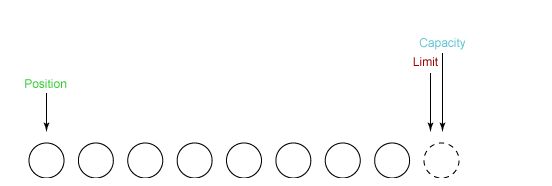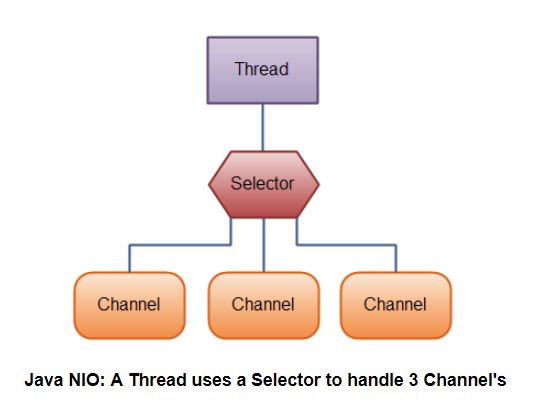NIO
新的输入/输出 (NIO) 库是在 JDK 1.4 中引入的,弥补了原来的 I/O 的不足,提供了高速的、面向块的 I/O。
NIO核心组件:
- 通道(Channels)
- 缓冲区(Buffers)
- 选择器(Selectors)
流与块
I/O 与 NIO 最重要的区别是数据打包和传输的方式,I/O 以流的方式处理数据,而 NIO 以块的方式处理数据。
面向流的 I/O 一次处理一个 字节 数据:一个输入流产生一个字节数据,一个输出流消费一个字节数据。 为流式数据创建过滤器非常容易,链接几个过滤器,以便每个过滤器只负责复杂处理机制的一部分。不利的一面是,面向流的 I/O 通常相当慢。
面向块的 I/O 一次处理一个 数据块 ,按块处理数据比按流处理数据要快得多。 但是面向块的 I/O 缺少一些面向流的 I/O 所具有的优雅性和简单性。
I/O 包和 NIO 已经很好地集成了,java.io.* 已经以 NIO 为基础重新实现了,所以现在它可以利用 NIO 的一些特性。 例如,java.io.* 包中的一些类包含以块的形式读写数据的方法,这使得即使在面向流的系统中,处理速度也会更快。
通道与缓冲区
1. 通道
通道 Channel 是对原 I/O 包中的流的模拟,可以通过它读取和写入数据。
通道与流的不同之处在于,流只能在一个方向上移动(一个流必须是 InputStream 或者 OutputStream 的子类), 而通道是 双向 的,可以用于读、写或者同时用于读写。
通道包括以下类型:
- FileChannel:从文件中读写数据;
- DatagramChannel:通过 UDP 读写网络中数据;
- SocketChannel:通过 TCP 读写网络中数据;
- ServerSocketChannel:可以监听新进来的 TCP 连接,对每一个新进来的连接都会创建一个 SocketChannel。
2. 缓冲区
发送给一个通道的所有数据都必须首先放到缓冲区中,同样地,从通道中读取的任何数据都要先读到缓冲区中。也就是说,不会直接对通道进行读写数据,而是要先经过缓冲区。
缓冲区实质上是一个数组,但它不仅仅是一个数组。缓冲区提供了对数据的结构化访问,而且还可以跟踪系统的读/写进程。
缓冲区包括以下类型:
- ByteBuffer
- CharBuffer
- ShortBuffer
- IntBuffer
- LongBuffer
- FloatBuffer
- DoubleBuffer
缓冲区状态变量
- capacity:最大容量;
- position:当前已经读写的字节数;
- limit:还可以读写的字节数。
状态变量的改变过程举例:
① 新建一个大小为 8 个字节的缓冲区,此时 position 为 0,而 limit = capacity = 8。capacity 变量不会改变,下面的讨论会忽略它。

② 从输入通道中读取 5 个字节数据写入缓冲区中,此时 position 为 5,limit 保持不变。

③ 在将缓冲区的数据写到输出通道之前,需要先调用 flip() 方法,这个方法将 limit 设置为当前 position,并将 position 设置为 0。

④ 从缓冲区中取 4 个字节到输出缓冲中,此时 position 设为 4。

⑤ 最后需要调用 clear() 方法来清空缓冲区,此时 position 和 limit 都被设置为最初位置。

文件 NIO 实例
FileChannel的使用
- 开启FileChannel
- 从FileChannel读取数据/写入数据
3.关闭FileChannel
public class FileChannelDemo {
public static void main(String[] args) throws IOException {
//1.创建一个RandomAccessFile(随机访问文件)对象通过RandomAccessFile对象的getChannel()方法。
RandomAccessFile raf=new RandomAccessFile("demo6.txt","rw");
FileChannel fc=raf.getChannel();
//使用FileChannel的read()方法读取数据:
ByteBuffer byteBuffer=ByteBuffer.allocate(1024);
int bys=fc.read(byteBuffer);
//使用FileChannel的write()方法写入数据:
ByteBuffer byteBuffer2=ByteBuffer.allocate(1024);
byteBuffer2.put("hello".getBytes());
fc.write(byteBuffer2);
//3.关闭FileChannel
fc.close();
}
}
- 以下展示了使用 NIO 快速复制文件的实例:
public class CopyFile {
public static void main(String[] args) throws IOException {
String srcFile="国旗歌.mp4";
String destFile="demo3.mp4";
long start = System.currentTimeMillis();
//copyFile(srcFile,destFile); //共耗时:75309毫秒
//copyFile2(srcFile,destFile); //共耗时:153毫秒
//copyFile3(srcFile,destFile);//共耗时:282毫秒
//copyFile4(srcFile,destFile);//共耗时:44毫秒
copyFile5(srcFile,destFile);//共耗时:共耗时:113毫秒
long end = System.currentTimeMillis();
System.out.println("共耗时:" + (end - start) + "毫秒");
}
/**
* 基本字节流一次读写一个字节
*/
public static void copyFile(String srcFile,String destFile) throws IOException {
FileInputStream fis=new FileInputStream(srcFile);
FileOutputStream fos=new FileOutputStream(destFile);
int by=0;
while((by=fis.read())!=-1){
fos.write(by);
}
fis.close();
fos.close();
}
/**
* 基本字节流一次读写一个字节数组
*/
public static void copyFile2(String srcFile,String destFile) throws IOException{
FileInputStream fis=new FileInputStream(srcFile);
FileOutputStream fos=new FileOutputStream(destFile);
int len=0;
byte[] bys=new byte[1024];
while((len=fis.read(bys))!=-1){
fos.write(bys,0,len);
}
fis.close();
fos.close();
}
/**
* 高效字节流一次读写一个字节
*/
public static void copyFile3(String srcFile,String destFile) throws IOException{
BufferedInputStream bis=new BufferedInputStream(new FileInputStream(srcFile));
BufferedOutputStream bos=new BufferedOutputStream(new FileOutputStream(destFile));
int by=0;
while((by=bis.read())!=-1){
bos.write(by);
}
bis.close();
bos.close();
}
/**
* 高效字节流一次读写一个字节数组
*/
public static void copyFile4(String srcFile,String destFile) throws IOException{
BufferedInputStream bis=new BufferedInputStream(new FileInputStream(srcFile));
BufferedOutputStream bos=new BufferedOutputStream(new FileOutputStream(destFile));
int len=0;
byte[] bys=new byte[1024];
while((len=bis.read(bys))!=-1){
bos.write(bys,0,len);
}
bis.close();
bos.close();
}
/**
* 使用FileChannel复制文件
*/
public static void copyFile5(String srcFile,String destFile) throws IOException{
FileInputStream fis=new FileInputStream(srcFile);
//获取输入字节流的文件通道
FileChannel fcin=fis.getChannel();
FileOutputStream fos=new FileOutputStream(destFile);
//获取输出字节流的文件通道
FileChannel fcout=fos.getChannel();
//为缓冲区分配 1024 个字节
ByteBuffer buffer = ByteBuffer.allocateDirect(1024);
while(true){
//从输入通道中读取数据到缓冲区中
int r = fcin.read(buffer);
// read() 返回 -1 表示 EOF
if(r==-1){
break;
}
//切换读写
buffer.flip();
//把缓冲区的内容写入输出文件中
fcout.write(buffer);
//清空缓冲区
buffer.clear();
}
}
}
SocketChannel和ServerSocketChannel的使用
SocketChannel用于创建基于TCP协议的客户端对象,因为SocketChannel中不存在accept()方法, 所以,它不能成为一个服务端程序。 通过 connect()方法 ,SocketChannel对象可以连接到其他TCP服务器程序。
ServerSocketChannel允许我们监听TCP协议请求,通过ServerSocketChannel的**accept()**方法创建一个SocketChannel对象用户从客户端读/写数据。
- 服务端:
- 通过ServerSocketChannel 绑定ip地址和端口号
- 通过ServerSocketChannel的accept()方法创建一个SocketChannel对象用户从客户端读/写数据
- 创建读数据/写数据缓冲区对象来读取客户端数据或向客户端发送数据
- 关闭SocketChannel和ServerSocketChannel
public class Server {
public static void main(String[] args) throws IOException {
//通过ServerSocketChannel 的open()方法创建一个ServerSocketChannel对象
ServerSocketChannel ssc=ServerSocketChannel.open();
//1. 通过ServerSocketChannel 绑定ip地址和端口号
ssc.socket().bind(new InetSocketAddress(InetAddress.getByName("LAPTOP-D9966H06"),8888));
//2. 通过ServerSocketChannel的accept()方法创建一个SocketChannel对象用户从客户端读/写数据
SocketChannel sc=ssc.accept();
//3. 创建读数据/写数据缓冲区对象来读取客户端数据或向客户端发送数据
//读取客户端发送的数据
ByteBuffer buffer=ByteBuffer.allocate(1024);
//从通道中读取数据到缓冲区
sc.read(buffer);
StringBuffer sb=new StringBuffer();
buffer.flip();
while(buffer.hasRemaining()){
sb.append((char)buffer.get());
}
System.out.println(sb.toString());
ByteBuffer buffer2=ByteBuffer.allocate(1024);
//向客户端发送数据
buffer2.put("data has been received.".getBytes());
buffer2.flip();
sc.write(buffer2);
//4. 关闭SocketChannel和ServerSocketChannel
sc.close();
ssc.close();
}
}
- 客户端:
1.通过SocketChannel连接到远程服务器
2.创建读数据/写数据缓冲区对象来读取服务端数据或向服务端发送数据
3.关闭SocketChannel
public class Client {
public static void main(String[] args) throws IOException {
//1.通过SocketChannel连接到远程服务器
SocketChannel sc=SocketChannel.open();
sc.connect(new InetSocketAddress(InetAddress.getByName("LAPTOP-D9966H06"),8888));
//2.创建读数据/写数据缓冲区对象来读取服务端数据或向服务端发送数据
//向通道中写入数据
ByteBuffer buffer=ByteBuffer.allocate(1024);
buffer.put("hello".getBytes());
buffer.flip();
sc.write(buffer);
//读取从客户端中获取的数据
ByteBuffer buffer2=ByteBuffer.allocate(1024);
sc.read(buffer2);
StringBuffer sb=new StringBuffer();
buffer2.flip();
while(buffer2.hasRemaining()){
sb.append((char)buffer2.get());
}
System.out.println(sb.toString());
//3.关闭SocketChannel
sc.close();
}
}
DatagramChannel的使用
DataGramChannel,类似于java 网络编程的DatagramSocket类; 使用UDP进行网络传输 , UDP是无连接,面向数据报文段的协议。
- 服务端:
public class Server {
public static void main(String[] args) throws IOException {
DatagramChannel dc= DatagramChannel.open();
dc.bind(new InetSocketAddress(InetAddress.getByName("LAPTOP-D9966H06"),8888));
//创建读数据/写数据缓冲区对象来读取客户端数据或向客户端发送数据
//读取客户端发送的数据
ByteBuffer buffer=ByteBuffer.allocate(1024);
//从通道中读取数据到缓冲区
dc.receive(buffer);
StringBuffer sb=new StringBuffer();
buffer.flip();
while(buffer.hasRemaining()){
sb.append((char)buffer.get());
}
System.out.println(sb.toString());
ByteBuffer buffer2=ByteBuffer.allocate(1024);
//向客户端发送数据
buffer2.put("data has been received.".getBytes());
buffer2.flip();
dc.send(buffer2,new InetSocketAddress(InetAddress.getByName("LAPTOP-D9966H06"),9999));
dc.close();
}
}
- 客户端:
public class Client {
public static void main(String[] args) throws IOException {
DatagramChannel dc= DatagramChannel.open();
dc.bind(new InetSocketAddress(InetAddress.getByName("LAPTOP-D9966H06"),9999));
//创建读数据/写数据缓冲区对象来读取服务端数据或向服务端发送数据
//向通道中写入数据
ByteBuffer buffer=ByteBuffer.allocate(1024);
buffer.put("hello".getBytes());
buffer.flip();
dc.send(buffer,new InetSocketAddress(InetAddress.getByName("LAPTOP-D9966H06"),8888));
//读取从客户端中获取的数据
ByteBuffer buffer2=ByteBuffer.allocate(1024);
dc.receive(buffer2);
StringBuffer sb=new StringBuffer();
buffer2.flip();
while(buffer2.hasRemaining()){
sb.append((char)buffer2.get());
}
System.out.println(sb.toString());
dc.close();
}
}
通道之间的数据传输
在Java NIO中如果一个channel是FileChannel类型的,那么他可以直接把数据传输到另一个channel。
transferFrom() :transferFrom方法把数据从通道源传输到FileChannel
transferTo() :transferTo方法把FileChannel数据传输到另一个FileChhannel
public static void copyFile6(String srcFile,String destFile) throws IOException {
FileInputStream fis = new FileInputStream(srcFile);
//获取输入字节流的文件通道
FileChannel fcin = fis.getChannel();
FileOutputStream fos = new FileOutputStream(destFile);
//获取输出字节流的文件通道
FileChannel fcout = fos.getChannel();
//fcin通道中读出count bytes ,并写入fcout通道中
//fcin.transferTo(0,fcin.size(),fcout);
//或者
fcout.transferFrom(fcin,0,fcin.size());
}
选择器
NIO 常常被叫做非阻塞 IO,主要是因为 NIO 在网络通信中的非阻塞特性被广泛使用。
NIO 实现了 IO 多路复用中的 Reactor 模型,一个线程 Thread 使用一个选择器 Selector 通过 轮询的方式 去监听多个通道 Channel 上的事件,从而让一个线程就可以处理多个事件。
通过配置监听的通道 Channel 为 非阻塞 ,那么当 Channel 上的 IO 事件还未到达时, 就不会进入阻塞状态一直等待,而是继续轮询其它 Channel,找到 IO 事件已经到达的 Channel 执行。
因为创建和切换线程的开销很大,因此使用一个线程来处理多个事件而不是一个线程处理一个事件, 对于 IO 密集型的应用具有很好地性能。
应该注意的是,只有套接字 Channel 才能配置为非阻塞,而 FileChannel 不能, 为 FileChannel 配置非阻塞也没有意义。

使用Selector的优点:
使用更少的线程来就可以来处理通道了, 相比使用多个线程, 避免了线程上下文切换带来的开销。
1. 创建选择器
Selector selector = Selector.open();
2. 将通道注册到选择器上
ServerSocketChannel ssChannel = ServerSocketChannel.open();
ssChannel.configureBlocking(false);//通道必须配置为非阻塞模式
ssChannel.register(selector, SelectionKey.OP_ACCEPT);
通道必须配置为非阻塞模式,否则使用选择器就没有任何意义了,因为如果通道在某个事件上被阻塞,那么服务器就不能响应其它事件,必须等待这个事件处理完毕才能去处理其它事件,显然这和选择器的作用背道而驰。
在将通道注册到选择器上时,还需要指定要注册的具体事件,主要有以下几类:
- SelectionKey.OP_CONNECT
- SelectionKey.OP_ACCEPT
- SelectionKey.OP_READ
- SelectionKey.OP_WRITE
它们在 SelectionKey 的定义如下:
public static final int OP_READ = 1 << 0;
public static final int OP_WRITE = 1 << 2;
public static final int OP_CONNECT = 1 << 3;
public static final int OP_ACCEPT = 1 << 4;
可以看出每个事件可以被当成一个位域,从而组成事件集整数。例如:
int interestSet = SelectionKey.OP_READ | SelectionKey.OP_WRITE;
3. 监听事件
int num = selector.select();
使用 select() 来监听到达的事件,它会 一直阻塞直到有至少一个事件到达 。
4. 获取到达的事件
Set<SelectionKey> keys = selector.selectedKeys();
Iterator<SelectionKey> keyIterator = keys.iterator();
while (keyIterator.hasNext()) {
SelectionKey key = keyIterator.next();
if (key.isAcceptable()) {
// ...
} else if (key.isReadable()) {
// ...
}
keyIterator.remove();
}
5. 事件循环
因为一次 select() 调用不能处理完所有的事件,并且服务器端有可能需要一直监听事件,因此服务器端处理事件的代码一般会放在一个死循环内。
while (true) {
int num = selector.select();
Set<SelectionKey> keys = selector.selectedKeys();
Iterator<SelectionKey> keyIterator = keys.iterator();
while (keyIterator.hasNext()) {
SelectionKey key = keyIterator.next();
if (key.isAcceptable()) {
// ...
} else if (key.isReadable()) {
// ...
}
keyIterator.remove();
}
}
套接字 NIO 实例
public class NIOServer {
public static void main(String[] args) throws IOException {
//1. 创建选择器
Selector selector = Selector.open();
//2.将通道注册到选择器上
ServerSocketChannel ssChannel = ServerSocketChannel.open();
ssChannel.configureBlocking(false);
//通道必须配置为非阻塞模式,否则使用选择器就没有任何意义了
ssChannel.register(selector, SelectionKey.OP_ACCEPT);
ServerSocket ss=ssChannel.socket();
ss.bind(new InetSocketAddress("127.0.0.1",8888));
while (true){
//3. 监听事件
selector.select();
//4. 获取到达的事件
Set<SelectionKey> keys = selector.selectedKeys();
Iterator<SelectionKey> keyIterator = keys.iterator();
while (keyIterator.hasNext()) {
SelectionKey key = keyIterator.next();
if (key.isAcceptable()) {
ServerSocketChannel ssChannel1 = (ServerSocketChannel) key.channel();
// 服务器会为每个新连接创建一个 SocketChannel
SocketChannel sChannel = ssChannel1.accept();
sChannel.configureBlocking(false);
// 这个新连接主要用于从客户端读取数据
sChannel.register(selector, SelectionKey.OP_READ);
} else if (key.isReadable()) {
SocketChannel sChannel = (SocketChannel) key.channel();
System.out.println(readDataFromSocketChannel(sChannel));
sChannel.close();
}
keyIterator.remove();
}
}
}
private static String readDataFromSocketChannel(SocketChannel sChannel) throws IOException {
ByteBuffer buffer = ByteBuffer.allocate(1024);
StringBuilder data = new StringBuilder();
while (true) {
buffer.clear();
int r = sChannel.read(buffer);
if (r == -1) {
break;
}
buffer.flip();
int limit = buffer.limit();
char[] dst = new char[limit];
for (int i = 0; i < limit; i++) {
dst[i] = (char) buffer.get(i);
}
data.append(dst);
buffer.clear();
}
return data.toString();
}
}
public class NIOClient {
public static void main(String[] args) throws IOException {
Socket socket = new Socket("127.0.0.1", 8888);
OutputStream out = socket.getOutputStream();
String s = "hello world";
out.write(s.getBytes());
out.close();
}
}
内存映射文件
内存映射文件 I/O 是一种读和写文件数据的方法,它可以比常规的基于流或者基于通道的 I/O 快得多。
向内存映射文件写入可能是危险的,只是改变数组的单个元素这样的简单操作,就可能会直接修改磁盘上的文件。修改数据与将数据保存到磁盘是没有分开的。
下面代码行将文件的前 1024 个字节映射到内存中,map() 方法返回一个 MappedByteBuffer,它是 ByteBuffer 的子类。因此,可以像使用其他任何 ByteBuffer 一样使用新映射的缓冲区,操作系统会在需要时负责执行映射。
MappedByteBuffer mbb = fc.map(FileChannel.MapMode.READ_WRITE, 0, 1024);
NIO与IO对比
NIO 与普通 I/O 的区别主要有以下三点:
- NIO 是非阻塞的;
- NIO 面向块,I/O 面向流。
- NIO有选择器,而I/O没有。
Path
Java7中文件IO发生了很大的变化,专门引入了很多新的类来取代原来的 基于java.io.File的文件IO操作方式。
创建一个Path
使用Paths工具类的get()方法创建Path对象
public class PathDemo {
public static void main(String[] args) {
//方式一
Path path=Paths.get("demo5.txt");
System.out.println(path);
//方式二
Path path2 = FileSystems.getDefault().getPath("demo5.txt");
System.out.println(path2);
}
}
File和Path之间的转换,File和URI之间的转换
public class PathDemo2 {
public static void main(String[] args) {
Path path=Paths.get("demo5.txt");
File file=path.toFile();
URI uri=path.toUri();
System.out.println(path);
System.out.println(file);
System.out.println(uri);
}
}
demo5.txt
demo5.txt
file:///F:/Java_Review/05Java/JavaIO/demo5.txt
获取Path的相关信息
public class PathDemo3 {
public static void main(String[] args) {
Path path= Paths.get("demo3\\test3.txt");
System.out.println("文件名:"+ path.getFileName());
System.out.println("名称元素的数量:"+path.getNameCount());
System.out.println("父路径:"+ path.getParent());
System.out.println("根路径:"+ path.getRoot());
System.out.println("是否是绝对路径:"+path.isAbsolute());
//startWith() 参数既可以是字符串,也可以是Path
System.out.println("是否是以路径demo3开头:"+path.startsWith(Paths.get("demo3")));
System.out.println("该路径的字符串形式:"+path.toString());
}
}
文件名:test3.txt
名称元素的数量:2
父路径:demo3
根路径:null
是否是绝对路径:false
是否是以路径demo3开头:true
该路径的字符串形式:demo3\test3.txt
移除Path中的冗余项
\ .表示的是当前目录
\ ..表示父目录或者说是上一级目录
normalize() : 返回一个路径,该路径是取出冗余项的路径。
toRealPath() : 可以看成,先进行toAbsolutePath()操作,然后进行normalize()操作
public class PathDemo4 {
public static void main(String[] args) throws IOException {
Path path= Paths.get("./demo3");
System.out.println("original :"+ path.toAbsolutePath());
System.out.println("after normalize:"+ path.toAbsolutePath().normalize());
System.out.println("after toRealPath:"+ path.toRealPath());
}
}
original :F:\Java_Review\05Java\JavaIO\.\demo3
after normalize:F:\Java_Review\05Java\JavaIO\demo3
after toRealPath:F:\Java_Review\05Java\JavaIO\demo3
public class PathDemo5 {
public static void main(String[] args) throws IOException {
Path path= Paths.get("../JavaIO");
System.out.println("original :"+ path.toAbsolutePath());
System.out.println("after normalize:"+ path.toAbsolutePath().normalize());
System.out.println("after toRealPath:"+ path.toRealPath());
}
}
original :F:\Java_Review\05Java\JavaIO\..\JavaIO
after normalize:F:\Java_Review\05Java\JavaIO
after toRealPath:F:\Java_Review\05Java\JavaIO
Files
java.nio.file.Files类是和java.nio.file.Path相结合使用的
检查给定的Path在文件系统中是否存在
Files.exists():检测文件路径是否存在
public class FilesDemo {
public static void main(String[] args) {
Path path = Paths.get("demo5.txt");
//LinkOptions.NOFOLLOW_LINKS:表示检测时不包含符号链接文件。
boolean isExist= Files.exists(path,new LinkOption[]{LinkOption.NOFOLLOW_LINKS});
System.out.println(isExist);
}
}
创建文件/文件夹
Files.createFile():创建文件
Files.createDirectory(): 创建文件夹
Files.createDirectories(): 创建文件夹
public class FilesDemo2 {
public static void main(String[] args) throws IOException {
Path path= Paths.get("demo7.txt");
if(!Files.exists(path)){
Files.createFile(path);
}
Path path2=Paths.get("demo4");
if(!Files.exists(path2)){
Files.createDirectory(path2);
}
Path path3=Paths.get("demo5\\test");
if(!Files.exists(path3)){
Files.createDirectories(path3);
}
}
}
删除文件或目录
Files.delete():删除一个文件或目录
public class FilesDemo3 {
public static void main(String[] args) throws IOException {
Path path= Paths.get("demo7.txt");
Files.delete(path);
}
}
把一个文件从一个地址复制到另一个位置
Files.copy():把一个文件从一个地址复制到另一个位置
public class FilesDemo4 {
public static void main(String[] args) throws IOException {
Path srcPath= Paths.get("demo6.txt");
Path destPath=Paths.get("demo7.txt");
//Files.copy(srcPath,destPath);
//强制覆盖已经存在的目标文件
Files.copy(srcPath,destPath, StandardCopyOption.REPLACE_EXISTING);
}
}
获取文件属性
public class FilesDemo5 {
public static void main(String[] args) throws IOException {
Path path= Paths.get("demo7.txt");
System.out.println(Files.getLastModifiedTime(path));
System.out.println(Files.size(path));
System.out.println(Files.isSymbolicLink(path));
System.out.println(Files.isDirectory(path));
System.out.println(Files.readAttributes(path,"*"));
}
}
遍历一个文件夹
public class FilesDemo6 {
public static void main(String[] args) throws IOException {
Path path= Paths.get("demo3\\demo2");
DirectoryStream<Path> paths=Files.newDirectoryStream(path);
for(Path p:paths){
System.out.println(p.getFileName());
}
}
}
遍历整个文件目录
FileVisitor需要调用方自行实现,然后作为参数传入walkFileTree(); FileVisitor的每个方法会在遍历过程中被调用多次。
public class FilesDemo7 {
public static void main(String[] args) throws IOException {
Path path= Paths.get("demo3\\demo2");
List<Path> paths=new ArrayList<>();
Files.walkFileTree(path,new FileVisitor(paths));
System.out.println("paths:"+paths);
}
private static class FileVisitor extends SimpleFileVisitor<Path> {
private List<Path> paths;
public FileVisitor(List<Path> paths){
this.paths=paths;
}
@Override
public FileVisitResult visitFile(Path file, BasicFileAttributes attrs) throws IOException {
if(file.toString().endsWith(".txt")){
paths.add(file.getFileName());
}
return super.visitFile(file, attrs);
}
}
}
输出结果:
paths:[a.txt, test2.txt, test.txt, test3.txt]
